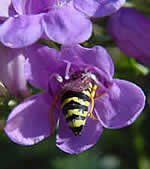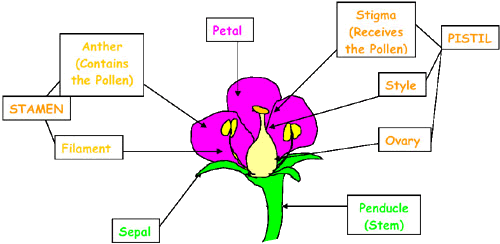- Forest Service Home
- Celebrating Wildflowers
- Home
- About Us
- News & Events
- Wildflower Viewing Areas
- Wildflower Ethics
- Forest Service Regions
- Just For Kids
- Teacher Resources
- Pollinators
- Native Gardening
- Native Plant Materials
- Invasive Plants
- Rare Plants
- Beauty of It All
- Interesting Plants
- Unique Communities
- Ethnobotany
- Special Features
- Wildflower Links
- Contact Us
USDA Forest Service Celebrating Wildflowers
|
|
|
What is Pollination?Pollination is the act of transferring pollen grains from the male anther of a flower to the female stigma. The goal of every living organism, including plants, is to create offspring for the next generation. One of the ways that plants can produce offspring is by making seeds. Seeds contain the genetic information to produce a new plant. Flowers are the tools that plants use to make their seeds. The basic parts of the flower are shown in the diagram below. Seeds can only be produced when pollen is transferred between flowers of the same species. A species is defined a population of individuals capable of interbreeding freely with one another but because of geographic, reproductive, or other barriers, they do not interbreed with members of other species.
How does pollen get from one flower get from one flower to another? Flowers must rely on vectors to move pollen. These vectors can include wind, water, birds, insects, butterflies, bats, and other animals that visit flowers. We call animals or insects that transfer pollen from plant to plant “pollinators”. Pollination is usually the unintended consequence of an animal’s activity on a flower. The pollinator is often eating or collecting pollen for its protein and other nutritional characteristics or it is sipping nectar from the flower when pollen grains attach themselves to the animal’s body. When the animal visits another flower for the same reason, pollen can fall off onto the flower’s stigma and may result in successful reproduction of the flower.  Pollen from the anthers of Flower 1 is deposited on the stigma of Flower 2. 0nce on the stigma, pollen may “germinate,” which means that a “pollen tube” forms on the sticky surface of the stigma and grows down into the ovule of the plant. This growth can result in:
Plants can be: |
|
| NOTE: PDF format links require the Adobe Acrobat Reader to view. | |
| top | Disclaimers | FOIA | Privacy Policy | Quality of Information | Photo Credits & Use |
Location: http://www.fs.fed.us/wildflowers/pollinators/whatispollination.shtml
Last modified: Wednesday, 17-Aug-2011 13:19:23 EDT

